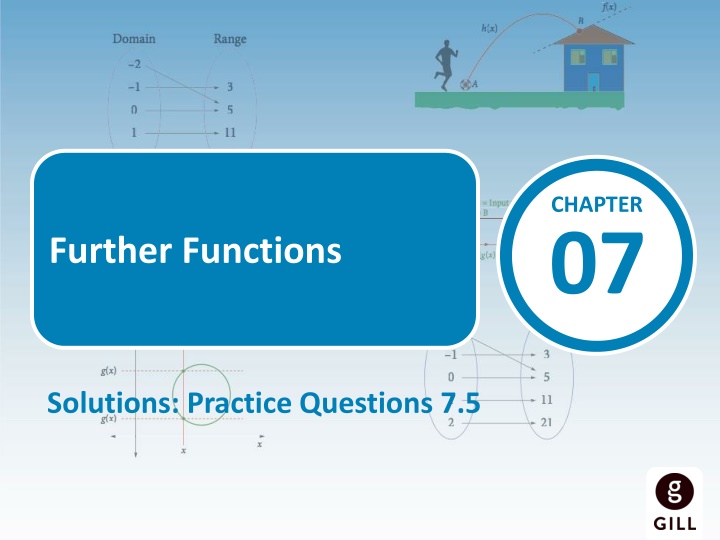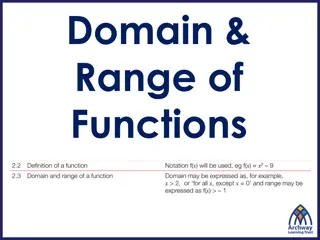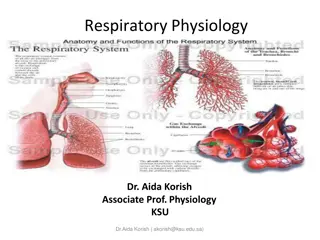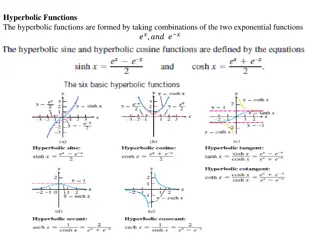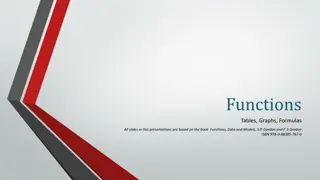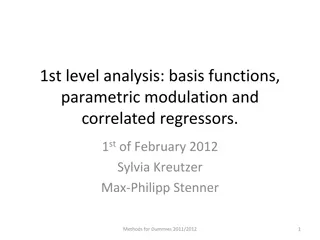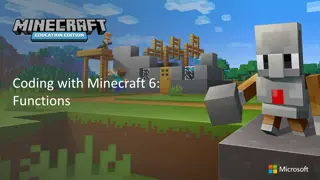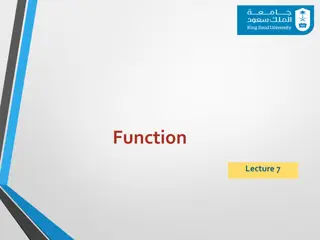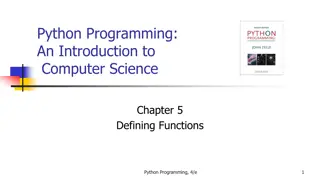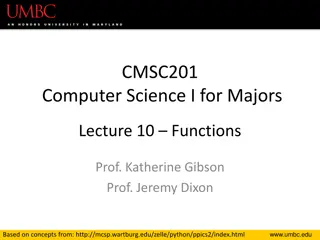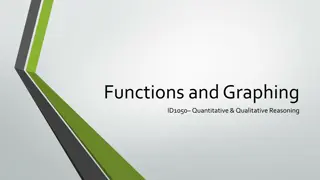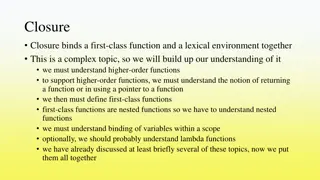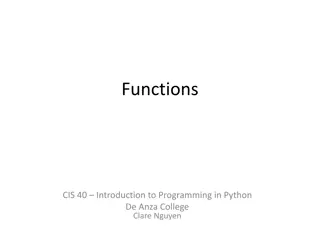Further Functions Solutions for Effective Learning
Enhance your understanding of functions through detailed solutions provided in Chapter 7.5. Dive deep into practice questions to master these concepts and boost your problem-solving skills in mathematics. Explore different problem-solving strategies and improve your proficiency in handling functions. Sharpen your skills and gain confidence in solving complex function-related problems with these comprehensive solutions.
Download Presentation

Please find below an Image/Link to download the presentation.
The content on the website is provided AS IS for your information and personal use only. It may not be sold, licensed, or shared on other websites without obtaining consent from the author.If you encounter any issues during the download, it is possible that the publisher has removed the file from their server.
You are allowed to download the files provided on this website for personal or commercial use, subject to the condition that they are used lawfully. All files are the property of their respective owners.
The content on the website is provided AS IS for your information and personal use only. It may not be sold, licensed, or shared on other websites without obtaining consent from the author.
E N D
Presentation Transcript
CHAPTER 07 Further Functions Solutions: Practice Questions 7.5
07 Practice Questions 7.5 1. The diagram shows the graph of a function k(x). Copy the graph into your copybook. Using the same axes and scale, graph the following: k(x) 3 (i) Draw a similar line, 3 units below the given line, k(x). k(x 3) (ii) Draw a similar line, 3 units to the right of the given line, k(x). k(x + 1) (iii) Draw a similar line, 1 unit to the left of the given line, k(x).
07 Practice Questions 7.5 2. The diagram shows the graph of a function g(x). Copy the graph into your copybook. Using the same axes and scale, graph the following: g(x) 2: Redraw g(x) graph, 2 units below the given graph. (i) g(x 2): Redraw g(x) graph, 2 units to the right of the given graph. (ii) 2g(x): Draw a graph with the same roots as g(x) but double the height. (iii) g(x): Draw the image of g(x) graph, as reflected in the x- axis. (iv)
07 Practice Questions 7.5 3. The diagram shows the graph of a function f (x) = x2 4. Copy the graph into your copybook. Using the same axes and scale, graph the following: g (x) = f (x) + 3 (i) moves the original graph f (x) up 3 units. k(x) = f (x + 1) 3 (ii) k(x) = f (x + 1) 3: Move 1 unit to the left and down 3 units. m(x)=1 4f (x) (iii) m(x)=1 4f (x): the curve f (x) will appear to compress (get vertically shorter). It will have the same roots as f (x) but only the height. 1 4
07 Practice Questions 7.5 4. The diagram shows the graph of a cubic function. Copy the graph into your copybook. Using the same axis and scale, graph the following: f (x) + 2 (i) f (x) + 2: Moves the graph up 2 units. f (x + 2) 1 (ii) f(x + 2) 1: Moves the graph 2 units to the left then down 1 unit.
07 Practice Questions 7.5 5. The diagram shows a graph of the function, f (x) = x 3. The graph is moved as shown: 6 units horizontally to the right 2 units vertically upwards. Write the function of the new graph, in terms of x. f(x) = x3 Moved 6 units to the right and 2 units up gives: New graph (x 6)3 + 2
07 Practice Questions 7.5 6. For each of the following, describe fully the transformation which maps the graph of f (x) onto the graph of g (x). f (x) = 3x onto g(x) = 3x + 2 (i) f(x) = 3x g(x) = 3x + 2 2 is added to the entire function, therefore it moves up two units. f (x) = x2 onto g(x) = x2 3 (ii) f(x) = x2 g(x) = x2 3 3 is subtracted from the entire function, therefore it moves down three units.
07 Practice Questions 7.5 6. For each of the following, describe fully the transformation which maps the graph of f (x) onto the graph of g (x). f (x) = 4x3 onto g (x) = 4(x + 5)3 (iii) f(x) = 4x3 g(x) = 4(x + 5)3 5 is added to the x part, therefore it moves the graph five units to the left. f (x) = 2x2 + 3x + 7 onto g(x) = 2x2 + 3x + 4 (iv) f(x) = 2x2 + 3x+ 7 g(x) = 2x2 + 3x + 4 3 is subtracted from the entire function, therefore it moves down three units.
07 Practice Questions 7.5 6. For each of the following, describe fully the transformation which maps the graph of f (x) onto the graph of g (x). f (x) = 6xonto g(x) = 6x 1 (v) f(x) = 6x g(x) = 6x 1 1 is subtracted from the x part, therefore it moves the graph 1 unit to the right. f (x) = 4x+ 3 onto g(x) = 4x + 2 + 2 (vi) f(x) = 4x+ 3 4x + 2 + 2 2 is added to the x part and 1 is subtracted from the entire function. Therefore, it moves the graph two units to the left then one unit down.
07 Practice Questions 7.5 7. Function A (blue) is defined by the equation y = x2. By observation, or otherwise, write down the equation of the functions B, C and D. A: y = x2 The graph of B is 3 units up above A, so we add 3 to the A function. B: y = x2 + 3 The graph of C is 2 units to the right of A, so we subtract 2 from the x part within the A function. C: y = (x 2)2 The graph of D is 3 units to the left and 2 units down from A, so we add 3 to the x part and subtract 2 from the entire A function. D: y = (x + 3)2 2
07 Practice Questions 7.5 8. The graph of y = f (x) is shown in red. Write down the equations of g (x) and h(x) in terms of f (x). g(x) has the same roots as f(x), but is 3 times higher. Therefore, g(x) = 3f (x). h(x) is two units to the left and two units above f(x), so we add 2 to the x part and also add 2 to the entire function to get: h(x) = f (x + 2) + 2
